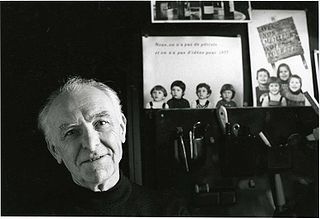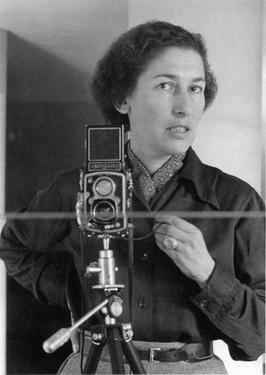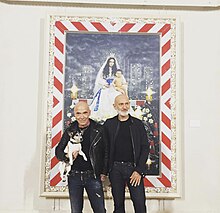
Jeu de Paume is an arts centre for modern and postmodern photography and media. It is located in the north corner of the Tuileries Gardens next to the Place de la Concorde in Paris. In 2004, Galerie Nationale du Jeu de Paume, Centre national de la photographie and Patrimoine Photographique merged to form the Association Jeu de Paume.

Henri Cartier-Bresson was a French artist and humanist photographer considered a master of candid photography, and an early user of 35mm film. He pioneered the genre of street photography, and viewed photography as capturing a decisive moment.
Edward Quinn (1920–1997) was born in Ireland. He lived and worked as a photographer from the 1950s, on the Côte d'Azur, during the "golden fifties" the playground of the celebrities from the world of show biz, art and business.

Robert Doisneau was a French photographer. From the 1930s, he photographed the streets of Paris. He was a champion of humanist photography and with Henri Cartier-Bresson a pioneer of photojournalism.
Gilles Larrain is a French-American photographer who believes photography is a way to "capture the landscape of the soul of a person". By taking a unique approach to photography, which includes creating his own lighting, managing the entire darkroom process, and always having subjects come to his personal studio space, Larrain has created acclaimed pieces of art since 1969. In 1973, Larrain published the highly successful photographic book, Idols, which presented portraits of transvestites. Two generations later, the book inspired American photographer Ryan McGinley who wrote an April 2010 article in Vice, which identified Larrain and the book Idols as one of his early and biggest influences for experimenting with colors, casting, and props, because all of Larrain's images in the book are raw without any manipulation. Larrain has photographed notable personalities in a wide range of creative disciplines, including the dancers of the American Ballet Theatre, Mikhail Baryshnikov, Salvador Dalí, Miles Davis, Sting, Billy Joel, Roberto Rossellini, Norman Mailer, and more.

Jean-Philippe Charbonnier was a French photographer whose works typify the humanist impulse in that medium in his homeland of the period after World War II.

Raymond Hains was a prominent French visual artist and a founder of the Nouveau réalisme movement. In 1960, he signed, along with Arman, François Dufrêne, Yves Klein, Jean Tinguely, Jacques Villeglé and Pierre Restany, the Manifesto of New Realism. In 1976, the first retrospective exhibition dedicated to Hains’ work was organized by Daniel Abadie at the National Center of Art and Culture (C.N.A.C.) in Paris. Hains named the show, which was the last one to be displayed at the C.N.A.C., La Chasse au C.N.A.C.. For it, Daniel Spoerri organized a dinner entitled La faim au C.N.A.C..
Guy Bourdin, was a French artist and fashion photographer known for his highly stylized and provocative images. From 1955, Bourdin worked mostly with Vogue as well as other publications including Harper's Bazaar. He shot ad campaigns for Chanel, Charles Jourdan, Pentax and Bloomingdale's.

Gisèle Freund was a German-born French photographer and photojournalist, famous for her documentary photography and portraits of writers and artists. Her best-known book, Photographie et société (1974), is a expanded edition of her seminal 1936 dissertation. It was the first sociohistorical study on photography as a democratic medium of self-representation in the age of technological reproduction. With this first doctoral thesis on photography at the Sorbonne, she was one of the first women habilitated there.

The Leopold Museum, housed in the Museumsquartier in Vienna, Austria, is home to one of the largest collections of modern Austrian art, featuring artists such as Egon Schiele, Gustav Klimt, Oskar Kokoschka, and Richard Gerstl.

David Rosenberg is a French art curator and author, specialized in modern and contemporary art styles.

Albert Watson OBE is a Scottish fashion, celebrity and art photographer. He has shot over 100 covers of Vogue and 40 covers of Rolling Stone magazine since the mid-1970s, and has created major advertising campaigns for clients such as Prada, Chanel and Levis. Watson has also taken some well-known photographs, from the portrait of Steve Jobs that appeared on the cover of his biography, a photo of Alfred Hitchcock holding a plucked goose, and a portrait of a nude Kate Moss taken on her 19th birthday.

Ervin Marton was a Hungarian-born artist and photographer who became an integral part of the Paris art culture beginning in 1937. An internationally recognized photographer, he is known for his portraits of many key figures in art, literature and the sciences working in Paris, as well as for his candid "street photography". His work was regularly exhibited in Paris during his lifetime, as well as in Budapest, London and Milan. It is held by the Hungarian National Gallery, the Bibliothèque Nationale in Paris, and the Hungarian Museum of Photography, as well as by major corporations and private collectors in Europe and the United States.

Charlélie Couture is a French and American musician and multi-disciplinary artist, who has recorded over 25 albums and 17 film soundtracks, and has held a number of exhibitions of paintings and photographs. He has also worked as a poster designer, and has published about 15 books of reflections, drawings and photographs.
Saâdane Afif is a French conceptual artist.

Vincent Fournier is a French artist and photographer. His works explore questions of science fiction, utopian stories ,and different mythologies of the future such as the space adventure, humanoid robots, utopian architectures, and the technological transformation of the living. His vision is nourished by childhood memories, including visits to the Palais de la Découverte, which evoke the "scientific wonder". While photography remains his preferred medium, 3D printing, video and installations sometimes accompany certain projects. Vincent Fournier's images are put in tension by oppositions that disturb our gaze: reality/fiction, logic/absurdity, past/future, magic/science, natural/artificial. He explores futuristic fiction and discovers in our present, or in the past, "glimpse of the future". After graduating in sociology and visual arts, he studied at the École nationale supérieure de la photographie in Arles and obtained his diploma in 1997.
The International Art Books and Films Festival or FILAF, is an international festival about artbooks and films which takes place annually in Perpignan since 2011. Its goal is to promote and award the best books and films about art produced each year in the world.
Jean-Claude Lemagny was a French library curator and historian of photography; a specialist in contemporary photography, he contributed to the world of fine-art photography in several roles.
Yvonne Chevalier was a French magazine photographer who was active from 1929 to 1970.

Hughes Dubois is a photographer specialized in the photography of artworks.













